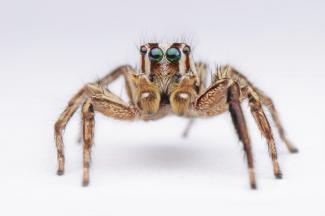
Instructions
Do the preparation exercise first. Then read the text and do the other exercises.
What do you know about spiders?
Spiders can be found on every continent of the planet except Antarctica. They are both hunters and hunted. They capture their prey in a variety of ways, either by spinning a web and waiting for their unsuspecting prey to fall into the trap, or jumping out of a hiding place onto a passing meal. Except for the plant-eating Bagheera kiplingi, these eight-legged invertebrates are serial carnivores: most love to snack on insects while others are tempted by lizards, birds, frogs, fish and the occasional snake. There are spiders that eat other spiders, and some female widow spiders eat their mates, even while they are mating. In turn, spiders are preyed on by lizards, birds, snakes and scorpions as well as some insects such as the mantis and a type of wasp that buries the arachnid alive! Spiders are also eaten by humans; they are a delicacy in some cultures of the South Pacific and a popular street food in South East Asia.
Spider venom is present in most species and serves the purpose of stunning or killing their prey rather than attacking humans. In fact, only 25 of the known spider species produce venom which can actually harm humans, and although spider bites can be painful, they are rarely deadly. Australia’s notorious Sydney funnel-web spider has not produced any fatalities since anti-venom was developed in 1981. However, take care not to rub hairy spiders like tarantulas up the wrong way. When they feel in danger, they defend themselves by ejecting a cloud of urticating hairs. These irritating hairs then embed themselves in the skin or eyes of the attacker.
Despite having adapted to a range of habitats and temperatures, spiders rarely stray far from their home environment. Ballooning spiders are an exception as they can migrate fairly long distances by drifting through the air with air-filled balls of silk. Spiders tend not to favour significant changes in temperature, and tropical spiders such as tarantulas prefer warm surroundings and find many European climates a little nippy. Even the ones who hitch a ride to Britain by boat or plane from the tropics don’t survive long.
Spiders can produce several different types of silk from their silk glands and nozzles, otherwise known as spinnerets. They range from stickier threads used to weave webs to capture their prey to incredibly strong threads which can support their own weight. The toughest spider silk is up to six times stronger than human bone, and that made by orb-weaver spiders is on a par with the strength of steel. In fact, some experts suggest that spider silk would be more effective than Kevlar in bulletproof vests. However, harvesting the thread on spider farms is complicated as these territorial creatures prefer their own company and could end up killing each other. Nevertheless, having studied the complex nature of spider silk, scientists have managed to replicate the resilient fibres, which has enormous potential for developing a range of things from synthetic muscle tissue to high-performance sports clothing.
Arachnophobia, or the irrational fear of spiders, is among the most common phobias in the Western world. It is thought to date back thousands of years and might be the result of an instinctive response displayed in early humans. For a long time throughout Europe, spiders were wrongly believed to spread diseases such as the plague. However, out of all the known spider species on the planet, only around 2% are actually harmful to humans. Other cultures such as Native Americans depict them in a more favourable light as they believe spiders are lucky and consider them symbols of wisdom.
How do you feel about spiders? What do people in your culture think about them? What have you learned from this text?

Comments